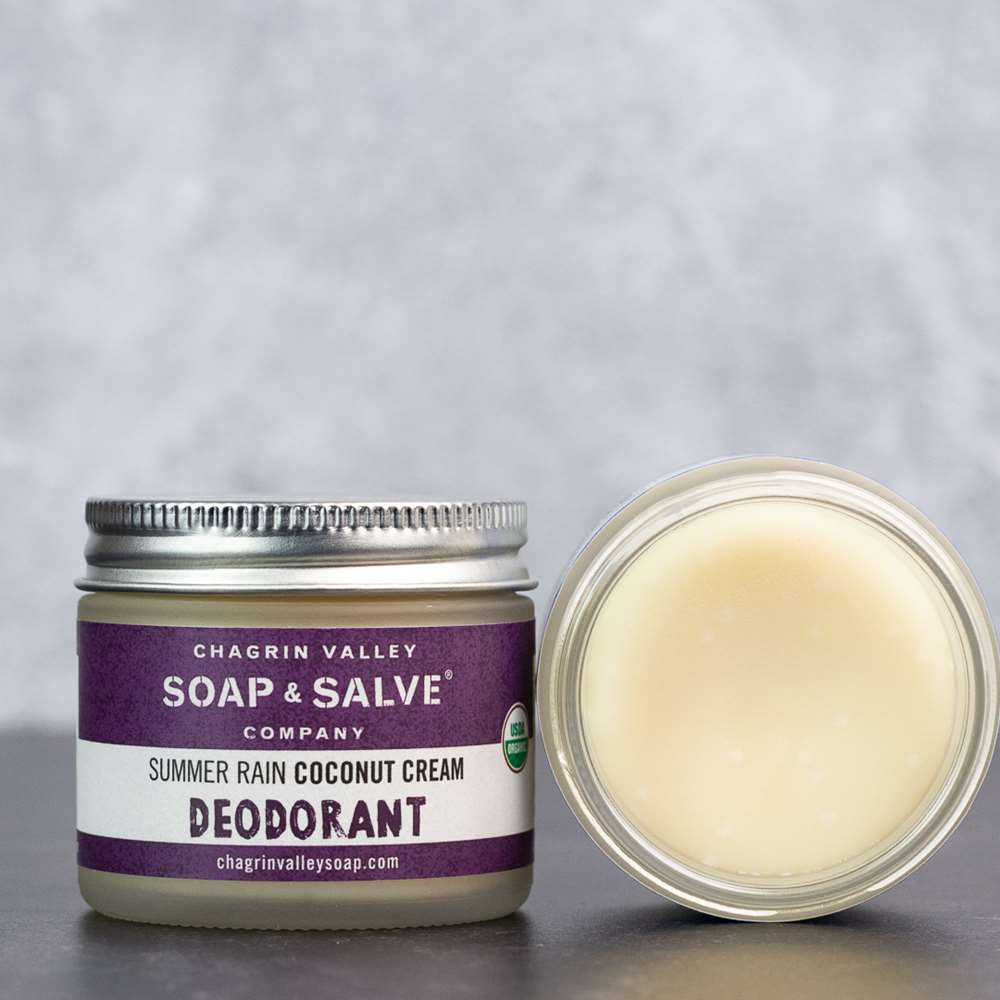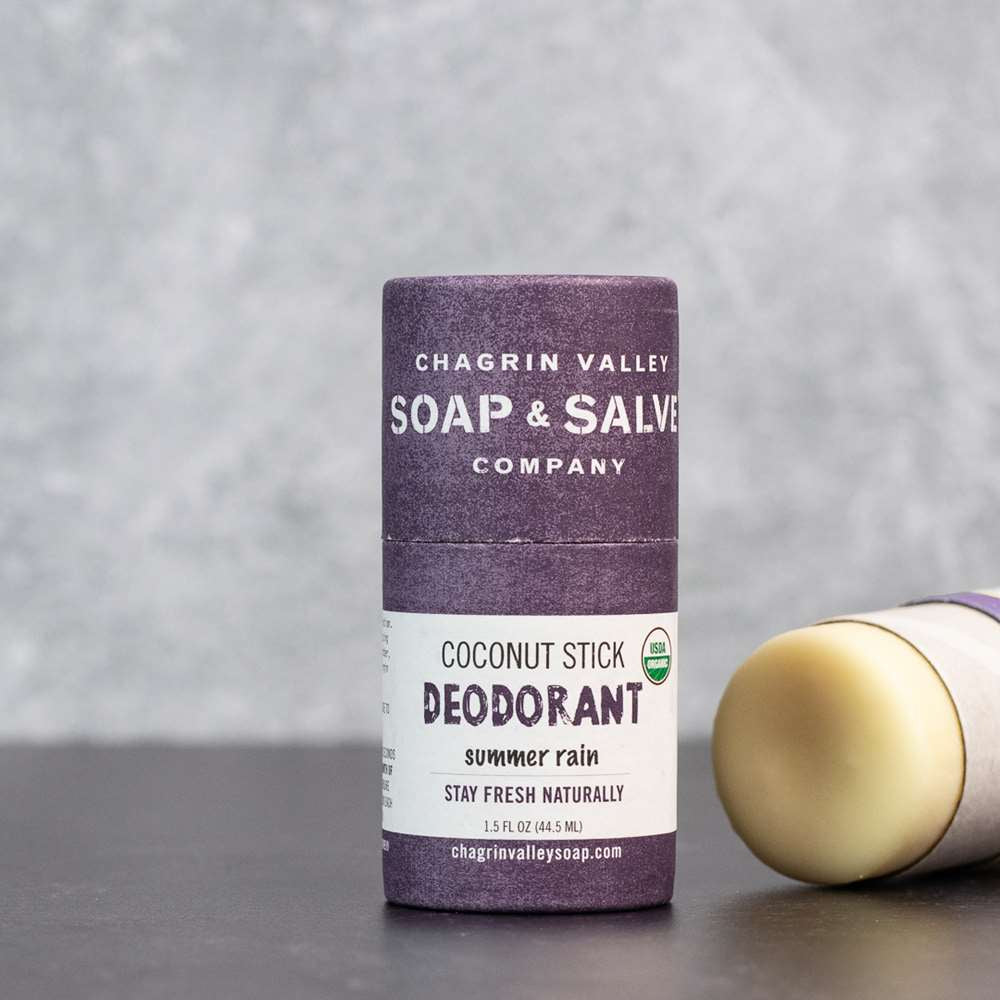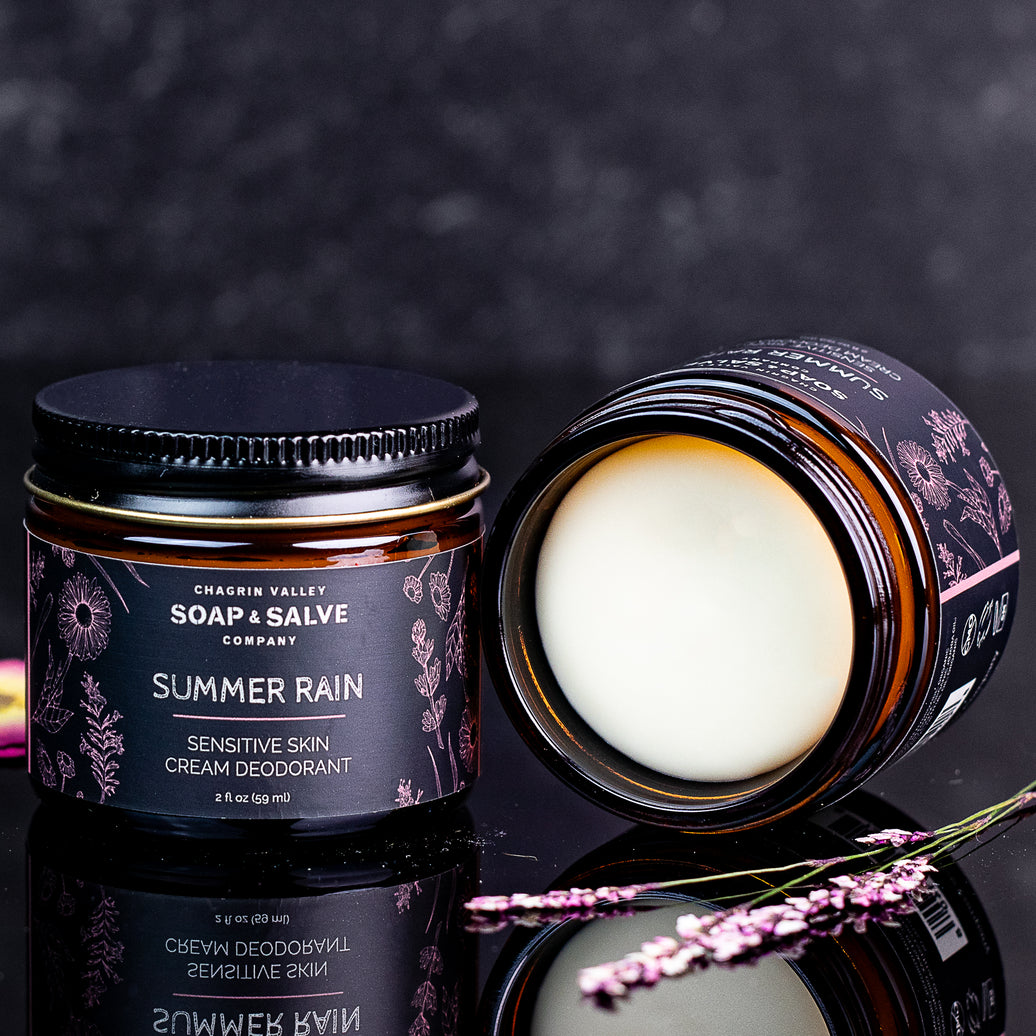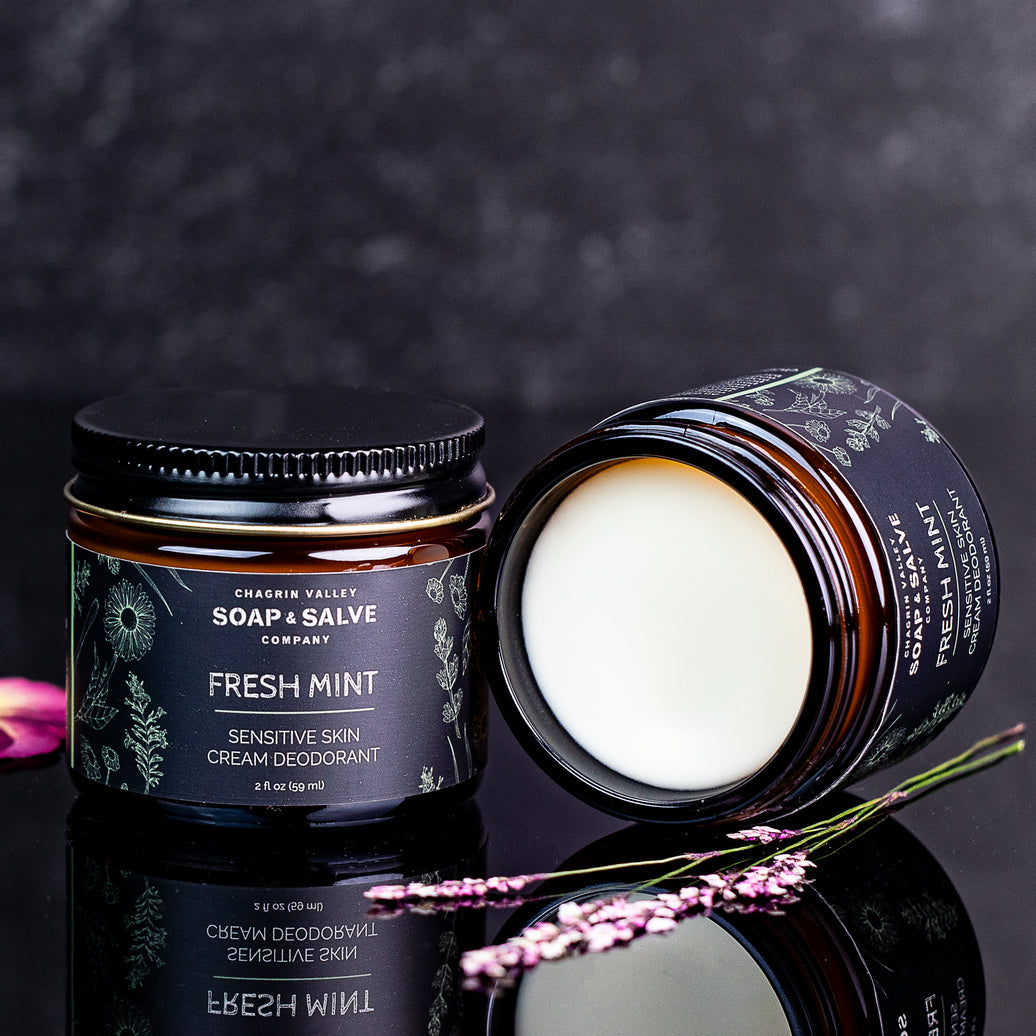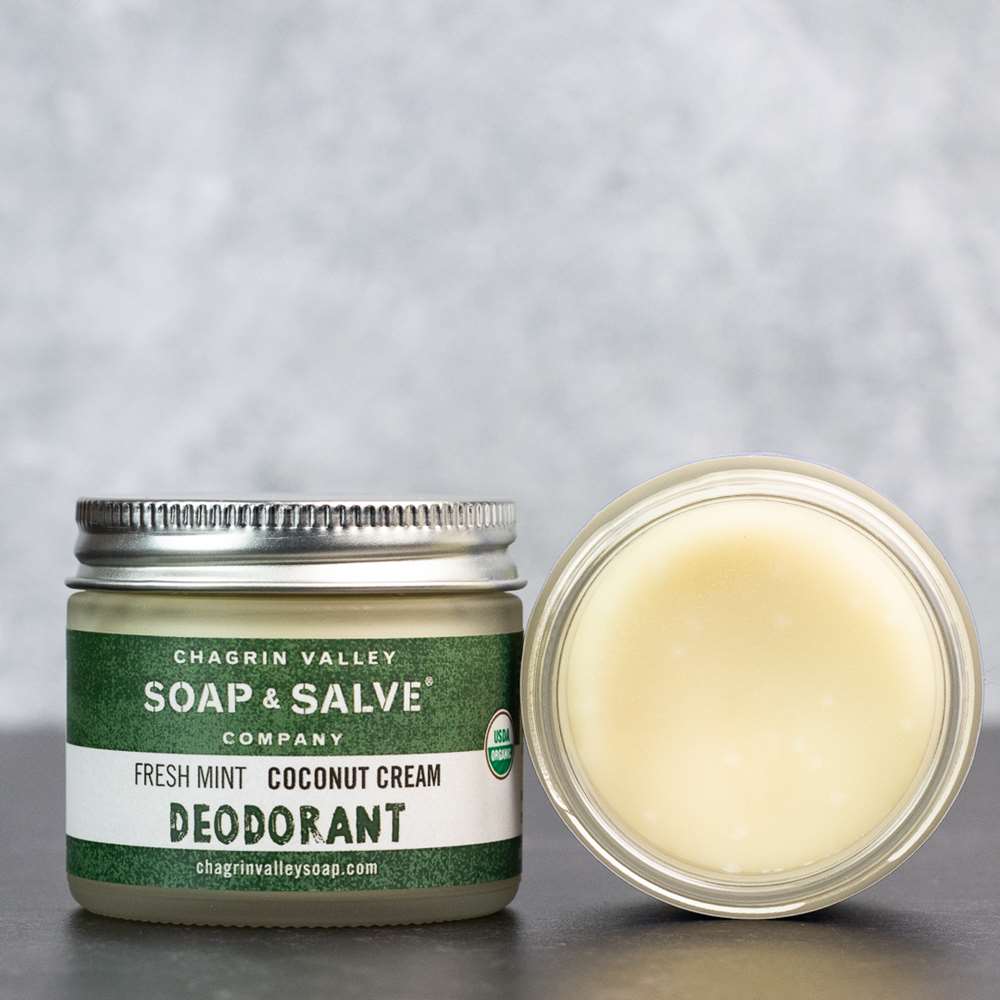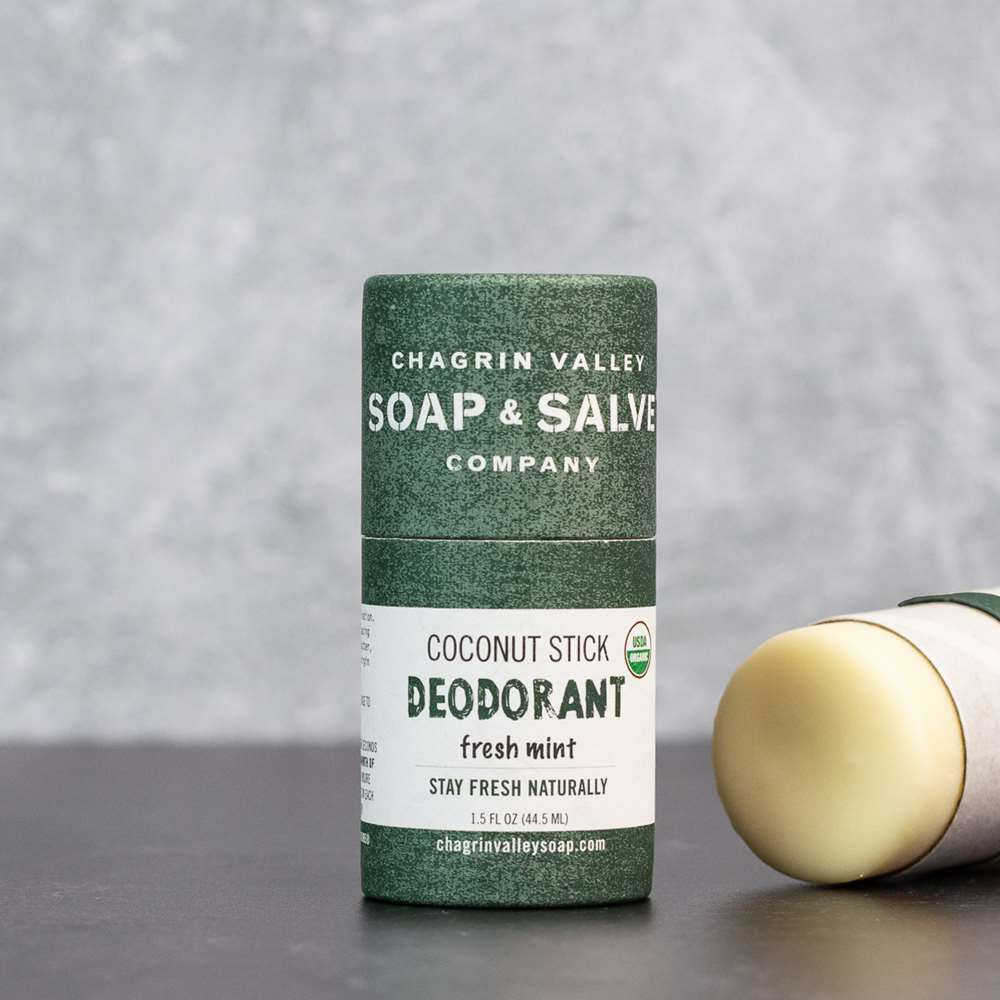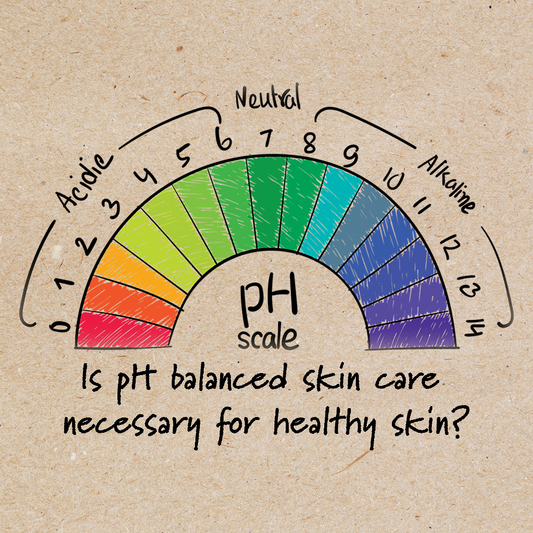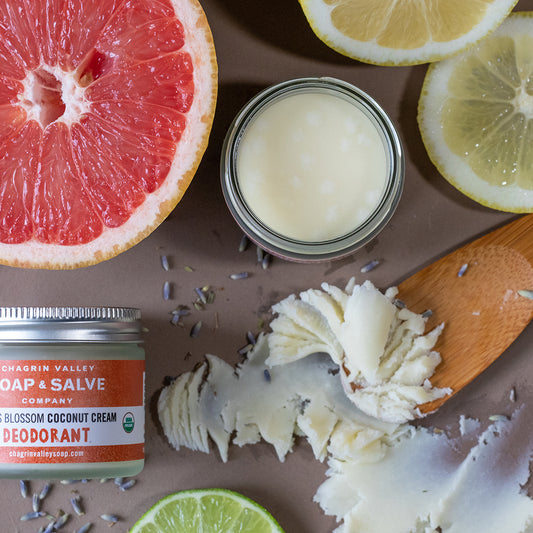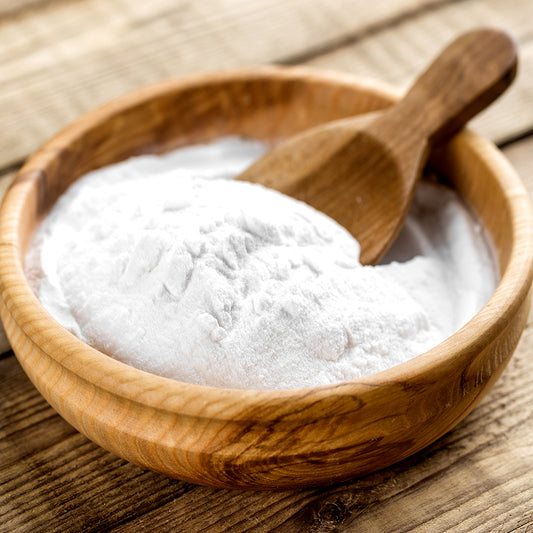Transitioning to Natural Deodorant: Why Do Some Experience an Adjustment Period?
Switching from an antiperspirant or a commercial deodorant
to a natural deodorant will be a unique experience for each person

Have you made the switch to organic or natural personal care products, but hesitate when it comes to using a natural deodorant? You are not alone.
Many people who advocate an “all-natural” way of living have trouble giving up their conventional deodorant or antiperspirant, even though they desperately want to make the change to safer, plant-based ingredients.
Will they work? Will they decrease odor? What about sweating? There are so many questions.
Since there is so much information to share I have divided this blog into two parts.
Part 1 discusses the adjustment period and the possible causes of irritation and or rashes that some may experience when switching from a conventional antiperspirant/deodorant to an all natural deodorant.
Part 2 provides some suggestions to help with the adjustment period and or to help alleviate the causes of irritation reviewed below. Part 2 also answers some common questions about using a natural deodorant.
I switched from antiperspirants to natural deodorants about 11 years ago, after I was diagnosed with breast cancer. If you read my three-part blog, “Antiperspirants & Breast Cancer,” you know that while I don’t agree with the hype that antiperspirants cause breast cancer, I wrote a fourth blog that asked the question, “Why Use A Natural Deodorant.”

My answer was simple, “Why Not?” If you are a regular reader of “Ida’s Soapbox,” there is one comment that keeps popping up. "It's What We Don't Know That Worries Me!” and it is worth repeating.
I have been using my homemade deodorants since 2008. I have very sensitive underarms and I will admit that my skin prefers some of our natural deodorants over others.
We sell thousands of natural deodorants each year. While many people transition seamlessly to a natural deodorant, others report a temporary transition period.
As you anticipate what to expect when transitioning to a natural deodorant, please always remember that each of us is a unique individual and our bodies are all quite different.
The bottom line with natural deodorants—it is all about what works for your body.
A lot depends on the type of bacteria lives on your skin and your own body chemistry which varies with your genetics, gender, age, race, diet, lifestyle, hormones, health, medications and even the clothes that you wear. This is why a deodorant that works for one person may not work for another.
Switching to natural deodorant may take some time and patience. But we believe it is worth the effort knowing you are no longer subjecting your delicate underarm skin to harsh chemicals. Allow your armpits to experience the freedom of natural deodorant.
So let’s explore!
- What Causes an Armpit Adjustment Period?
- What To Expect If You Have a Natural Deodorant Transition Period
- Possible Causes of Irritation
- Rashes
What Causes An Armpit Adjustment Period?
Anytime you make a change to the products that you put on your skin, there is a potential for irritation or problems to occur. This remains true for a switch to natural deodorant.
Underarm Skin is More Sensitive
Did you ever notice that so many people are ticklish under their arms? The underarm area is one of the most sensitive parts of the body. Although we do not often think about armpit "care," our armpits need a lot of TLC.
- Underarm skin is thinner than the skin on other parts of your body
- This thin, delicate skin, prone to allergic reactions, fosters irritation
- Underarm skin is not exposed to outside elements which can make skin "tougher"
- Underarms usually get very little sunlight
- The warm, moist environment is a breeding ground for bacteria
- The friction that occurs when underarms rub against skin or clothing can cause skin irritation
- Underarms are home to lots of nerves and lymph nodes
You may notice that you can feel a simple touch more than you can on other areas of the body. When you add up all of these factors you can see why underarm skin is not only more sensitive, but also more prone to irritation.
Your Body Chemistry Has Become Happy With Your Typical Deodorant
Most commercially made deodorants contain a variety of synthetic chemicals that artificially keep your underarms odor free as you sweat.
Antiperspirants contain aluminum salts that are intended to clog your pores and sweat glands as a way to reduce or prevent the natural process of sweating. When you stop using antiperspirant and switch to natural deodorant, your underarms are able to sweat again.
Over time, your body has slowly become accustomed to these ingredients, so much so that the body chemistry of your armpits has changed to accommodate them. So when you switch to a natural deodorant imagine what is happening in your armpit. After not sweating or smelling for so many years your underarms begin to "freak out," AKA transition period.
The Microbiome in the Armpit Must Return To Its Original Composition
The human armpit provides lovely conditions for bacteria to thrive. Most of us have billions of bacteria living in each armpit. This region is moist, warm, and usually dark—the perfect home.

Scientists have discovered that the long-term use of antiperspirants actually changes the types and number of bacteria that live in the armpit. These products actually change the entire microbiome in the armpit region.
A study published in 2016 looked at the effect of the habitual use of antiperspirants on the microbiome of the armpit. The research was done by scientists at the North Carolina Museum of Natural Sciences, North Carolina State University, North Carolina Central University, Rutgers University, and Duke University.
“Using antiperspirant and deodorant completely rearranges the microbial ecosystem of your skin – what’s living on us and in what amounts, and we have no idea what effect, if any, that has on our skin and on our health."
The researchers found that people who use antiperspirants, and even some commercial deodorants, have a greater number of bacterial species in the armpit area. This does not mean that it is bad or has an adverse effect on health, just that bacterial populations are very different from those who do not use these products.
“The human armpit has long been noted to host a high biomass bacterial community… and recent studies have highlighted substantial inter-individual variation in armpit bacteria . . . One obvious potential explanation for this variation has to do with the use of personal hygiene products, particularly deodorants and antiperspirants. Our work clearly demonstrates that antiperspirant use strikingly alters armpit bacterial communities, making them more species rich.” (Source)
What does this mean for the individual that wants to make the switch to natural deodorant? Since the human armpit microbiome is very complicated and quite unique to an individual, it is difficult to predict whether or not, or even how a change in deodorant will affect each person. We do know that the microbiome will change and that it takes time for the natural microbiome of the armpit to re-establish itself.
So you decide to stop using your commercial deodorant or antiperspirant. At first, all goes well. But then within a few days after discontinuing your antiperspirant, the armpit bacterial populations begin to change.
As the new bacteria begin to colonize you may notice an increase and a change in the underarm odor.
If you read the blog, "The Science of Sweat," you will remember that the majority of sweat glands found all over our body are called eccrine glands. The “sweat” from these glands which is composed mainly of water, salt and trace amounts of other electrolytes does not contribute to body odor.
 There is a second type of sweat glands, apocrine glands, are found in areas with lots of hair follicles like the scalp, armpits, and groin.
There is a second type of sweat glands, apocrine glands, are found in areas with lots of hair follicles like the scalp, armpits, and groin.
These glands secrete a thicker fatty sweat that also contains proteins. These odorless secretions are quickly inhabited by the bacterial biome that lives in the armpit. Underarm odor results when bacterial enzymes breakdown this sweat.
Scientists have determined that since different bacteria produce different enzymes, different bacteria also produce different odors. Thus, our underarm odor is the result of the type and amount of bacteria that inhabit our armpits.
Logic follows that as the composition of armpit bacteria changes, so will the underarm odor.
But sadly since most people do not understand the bacterial battle that is occurring in their armpits, they often toss out the natural the deodorant assuming that it is not working.
It may take 2 to 4 weeks for your armpits to adjust to the change in routine as your new bacterial microbiome finally settles down.
Our bodies are quite resistant to change. Our bodies enjoy the status quo. They see change as a disruption and often resist change even if it is a positive one. When we change anything, especially something we have been doing for a long time whether it be diet, exercise, skin care, shampoo, or deodorant, our body simply needs time to adjust and accept the change.
Do I Need An Armpit Detox?
We have all heard about detox diets and cleanses for your body. Well now some people are advocating a detox for armpits. The ritual usually involves mixing up armpit masks made with charcoal, clays, or apple cider vinegar and applying them to your armpits to supposedly help “detox” the harmful chemicals that may have built up due ingredients in conventional deodorant or antiperspirants.
The idea behind the armpit detox is that it helps make the transition from an aluminum-based antiperspirant to a natural deodorant easier. However, there is no evidence that an underarm detox will reduce odor or make your new natural deodorant more effective.
 As I explained above, we do know that commercial deodorants and antiperspirants change the types and amounts of bacteria in the armpit.
As I explained above, we do know that commercial deodorants and antiperspirants change the types and amounts of bacteria in the armpit.
Now that you know why armpit odor changes and why you may sweat more initially, please do not allow a company to tell you that the increase in odor and/or sweat is the result of your body expelling or flushing out toxins. Your body has a great natural detox system that includes your liver and your kidneys, but your skin--not so much.
What people call and Armpit "detox" is simply a normal adjustment period. You do NOT need to buy armpit "detox" kits.
A simple wash with a gentle soap and water will remove antiperspirant or deodorant on your skin and help control odor.
The bottom line--our body needs time to adjust to change and time to allow the bacterial microbiome to balance out. The timeline varies from person to person.
An Analogy! Have you ever tried changing your diet from processed junk food to healthy food?
If so, you probably experienced a lot of trouble with your digestive system at first. You would think that your body would be happy that you are eating healthy food, but any changes you make to your diet will also affect your gut bacteria. The bacteria in your gut that love junk food are now quite unhappy which may actually sabotage your attempt to eat better.
As new bacteria begin to colonize your gut, these discomforts will disappear. But it takes patience and commitment!
The reverse is also true. After six months on a healthy diet, reverting to processed food will wreak havoc on the bacteria that loved the fruits and vegetables resulting in uncomfortable gut disturbances.
What To Expect If You Have a Natural Deodorant Transition Period
People often try natural deodorant for a few days or a week. If their underarm odor increases they blame the natural product. We hope that by understanding what is going on in your armpits, you realize that the odor is usually temporary.
It can take up to 30 days for your body to regulate itself again and learn to sweat naturally. Although it does not take this long for everyone.
In a study entitled "Deodorants and Antiperspirants Affect the Axillary Bacterial Community" published in 2014 in the Archives of Dermatological Research by Chris Callewaert, et al., researchers found that some of the ingredients in deodorants and antiperspirants can actually "persist in the underarm skin up to three to four weeks after usage."
They noted that some of those chemicals will only disappear completely when your skin completely renews itself with normal skin cell turnover, which takes about four weeks in the middle-aged adult. As we grow older, this skin cycle slows.
We hope that knowing what to expect, will help you prepare for a few weeks of adjustment as you transition into a healthier life choice. While the timeframe for adjustment, if you experience one, is different for each person depending on your body chemistry, here is a typical scenario.
WEEK 1
You decide to stop using your commercial deodorant or antiperspirant. In the United States, the FDA classifies antiperspirants as over-the-counter drugs. If you have been using an antiperspirant for years your sweat glands will definitely be expecting it.
At first, all goes well. You may go for a few days or even a week without noticing much difference between your antiperspirant and natural deodorant. Now you are thinking, WOW this is great! Natural deodorant really works!
WEEK 2
Within a few days after discontinuing use, the armpit bacterial populations begin to change. As the new bacteria begin to colonize you may notice an increase and a change in the underarm odor.
If you have been using an antiperspirant, the pores in your armpit have been blocked every day for decades. Your body will often temporarily increase sweat production before your sweat glands can start behaving normally again.
This is the point, with the temporary increase in sweating and change in body odor when people often toss out the natural deodorant assuming that it is not working. But when you first make the switch, it is not that your natural deodorant is not working properly, its that your body is! Probably for the first time is a long while.
Natural deodorant is an entirely different product than conventional deodorants or antiperspirants. Patience is key. Give your body time to transition.
Remember, the increase in odor and/or sweat is NOT the result of expelling toxins and there is no evidence that an armpit detox will help anything.
Just know that if you return to your old antiperspirant or deodorant when you decide to try a natural deodorant again, your armpits will need time to re-regulate themselves--all over again.
WEEK 3
The bacterial communities under your arms continue to change as the armpit bacterial microbiome is re-balancing to its new normal.
You should notice odor issues decreasing and perspiration levels beginning to normalize.
One interesting note is that switching to natural deodorants may actually reduce underarm odor over time. Antibacterial agents and preservatives in commercial deodorant are very good at killing bacteria, good and bad, which disrupts the natural armpit microbiome. Once the underarm is finally able to repopulate and rebalance the good and bad bacteria, odor often decreases.
WEEK 4
Your natural armpit microbiome is back in place and your body should have fully adjusted to natural deodorant.
If you still are experiencing irritation it could be the baking soda, but it could also be any of one of the ingredients. You can be sensitive to an ingredient even if it is natural. A patch test may help rule out ingredient sensitivities.
- read the suggestions below--applying too much deodorant is often the culprit
- if you are using a deodorant with essential oils, try one with no added scent
- try a different formulation--we have 3 different deodorant recipes each with different scents: a Deodorant Stick, Extra Strength Cream and Sensitive Skin Cream
Please note: Continuous stinging, burning, itching, or rashes are signs that the product is not compatible with your skin. Again, it does NOT mean that you are going through detox or need to buy "detox" kits to "draw out the toxins." If nothing seems to help, please discontinue use.
We have been told by many customers, friends and family members that they were surprised to discover that after a few months of use they could actually skip a day without deodorant and have no problems with odor.
Customer Comment: It wasn't as easy as I hoped but not that bad either. It took about 3 weeks. It's been 4 months using the lemongrass stick deodorant. Love it!!! Just want to tell you guys the funny thing is I sweat less than when using my antiperspirant and that makes no sense. And I used to panic if I forget to put on deodorant and now I can miss a day and still not smell. Can't explain it but I'm happy and my armpits are happy and I like it all. --Wendy, Texas
Other Possible Causes of Irritation
Baking Soda
 Baking Soda is effective at absorbing all types of moisture, including sweat, which makes it useful for keeping underarms dry.
Baking Soda is effective at absorbing all types of moisture, including sweat, which makes it useful for keeping underarms dry.
It also effectively kills odor causing bacteria. By neutralizing the acid in sweat, the underarm environment becomes less friendly to odor-causing bacteria thus preventing body odor from forming.
Although some choose to stay away from baking soda, others actually prefer it because it is the only thing that actually works for them!
Human sweat is slightly acidic with a pH range of 4 to 6. The pH of perspiration varies from person to person and is affected by age, gender, race, medication, diet, or even hormonal changes that can occur during pregnancy, menopause or your monthly period. The natural pH of an individual's sweat can actually cause an irritation or even a burning sensation when mixed with baking soda.
Why? Baking soda is slightly alkaline with a pH range of 8 to 9. If your sweat is more on the acidic side, there may actually be a little chemical reaction between the alkaline baking soda and the acidic sweat. Think of the “volcanoes” you made in science class with alkaline baking soda and acidic vinegar. If your sweat is more acidic, this little volcano can cause an irritation called “Irritant Contact Dermatitis.”
I have read on many websites that a rash after using a baking soda deodorant always means that a baking soda deodorant is bad.
While baking soda in deodorant is often blamed for irritating skin and causing red, raw underarms, the baking soda itself is not always the culprit. Some companies simply use too much baking soda in their natural deodorants which creates a gritty, abrasive texture that feels like you are rubbing sandpaper against your skin. That friction alone can seriously irritate the delicate skin under your arms. You will see below that there are many other factors to consider.
Some people are predisposed to be hypersensitive to baking soda, while others experience zero issues. We spent over a year working on our deodorant formulations using many, many of our human guinea pigs. What we discovered was that in general, baking soda tends to perform better at fighting odors than other ingredients found in natural deodorants.
If you are concerned about a baking soda sensitivity or have already experienced an irritation when first switching deodorants try one of our baking soda-free Sensitive Skin Deodorants. They are made with magnesium hydroxide instead of baking soda.
Learn More: Magnesium Hydroxide vs Baking Soda
Deodorant Application
Believe it or not, something as simple as the proper application of natural deodorant can affect the chance of irritation.
Rubbing too vigorously, applying too much or applying to wet skin may decrease your chance of a good experience.
Natural deodorant formulations are very different from their conventional counterparts. Synthetic ingredients present in commercial deodorants and antiperspirants like dimethicone, cyclopentasiloxane, propylene glycol, polyethylene glycol (PEG) and phthalates function to increase smoothness, slip, and glide, to emulsify ingredients, to provide firmness and pliability and even to make it easier to wash off the product.
In other words, these ingredients give your commercial deodorant the application texture that you are accustomed to experiencing.
As would be expected, without all of these synthetic ingredients, the texture of a natural deodorant will feel different during application.
Whether you apply a natural cream or stick deodorant it will take some time, practice and patience. I will cover this in more detail in Part 2 of this blog.
Sweat Chafing
 I already discussed how very acidic perspiration can lead to irritation with baking soda-based deodorants.
I already discussed how very acidic perspiration can lead to irritation with baking soda-based deodorants.
But even without baking soda, your own sweat can cause many other irritations.
If you have muscular thighs or chubby thighs (like I do) imagine walking for eight hours in hot, humid, sweaty weather with your bare thighs rubbing together.
Some of you may already be wincing because you have experienced that irritation on your inner thighs called chafing.
Sweat is a normal and healthy part of being human! The sweat itself is clear and odorless. Read more about “The Science of Sweat.”
Remember, natural deodorant is not an antiperspirant. Antiperspirants actually travel into and block your sweat glands preventing moisture from escaping your body.
If you recently stopped using an antiperspirant, which stops your sweat glands from functioning normally, there is nothing to keep you from sweating. Your body may actually temporarily increase sweat production when you stop antiperspirants.
Without an antiperspirant, your underarms are going to be more moist. As the moist skin moves and rubs against itself, that friction produces an irritation called chafing. You may notice a red, irritated spot in the crease of your underarm that may itch, burn, or sting.
The salt residue that forms when sweat evaporates can add a grittiness that can cause even more friction and chafe--like continuously exfoliating your armpits with salt (ouch!!).
Shaving Irritation
Have you ever applied deodorant right after shaving and felt a burning or stinging sensation that may itch all day long? Your underarms are a very sensitive area of the body and razors cause microscopic tears, actual little open wounds, in the delicate armpit skin.
Applying deodorant directly after shaving can be irritating, even when using a natural deodorant.
While many deodorant websites will tell you to wait 10 minutes or so, we suggest shaving before bed to allow your underarms to rest, repair, and heal overnight before applying deodorant.
RASHES
Through our years of personal experience and research, there seem to be a few main causes/types of underarm rash.
Intertrigo
Since the armpit area is warm, moist, and lacks air circulation, sweat can build up which intensifies the skin-to-skin friction.
This can cause the chafed area to develop into a rash called Intertrigo. Intertrigo, an inflammation of the body folds, is the number one cause of underarm rashes when using deodorant instead of antiperspirant.
Intertrigo is the common rash that you see in the moist folds under the breasts or under a baby's chin or armpit.
This irritated and inflamed skin is vulnerable to bacterial and fungal infections. If it progresses untreated, it can become raw, red, and itchy. Of course, if your rash is infected or does not go away, please visit a doctor.
To prevent intertrigo, the key is to reduce the friction in the armpit.
Prickly Heat
 You don’t have to be a baby to get prickly heat.
You don’t have to be a baby to get prickly heat.
Prickly heat, sometimes called heat rash, sweat rash or by its medical name, Miliaria rubra, is an itchy rash of small, raised red spots that cause a stinging or prickling sensation on the skin. Sometimes the red bumps can develop into a series of tiny blisters.
It occurs when sweat becomes trapped underneath layers of skin. If you sweat more than usual, your sweat glands become overloaded.
This causes the ducts to become blocked trapping the sweat deep beneath your skin. Instead of evaporating, this trapped sweat irritates the skin and the skin responds by producing an inflammatory rash.
Unlike intertrigo, prickly heat is not confined to skin folds--it can appear anywhere and is often found just under the fold of the underarm. While it may spread on your own body, it is not contagious.
Contact Dermatitis
You may call it a rash but your doctor calls it "contact dermatitis."
Either way, contact dermatitis is a red, itchy irritation or rash that occurs when the skin comes in contact with a substance that triggers a reaction. The substance may be natural or synthetic.
The rashes are not contagious, but they can be very uncomfortable and may lead to an infection if you repeatedly scratch the affected area.
There are two major types of Contact Dermatitis: Irritant and Allergic
The symptoms of irritant and allergic contact dermatitis are very similar which often makes them difficult to tell apart.
Irritant Contact Dermatitis
Irritant contact dermatitis is the most common type of contact dermatitis.
This nonallergic skin reaction occurs when a substance irritates the protective outer layer of the skin. The nature and extent of the rash depend on
- how much of the irritant was present
- the strength of the irritant
- how long the irritant remained on the skin
- individual body chemistry
Although an irritant contact rash usually appears within minutes to hours after contact with the irritant trigger, the reaction depends on your sensitivity to the irritant as well as the strength of the irritant.
Contact with a weak irritant, like water (yes! water), baking soda, or urine (diaper rash), may not cause symptoms to develop until after repeated exposures. Some people may even develop a tolerance to a weak irritant over time. The irritation will often cause red, rough, and dry skin that may burn and sting.
However, contact with a strong irritant, like strong acids, alkalis or pepper spray, will cause an immediate reaction in everyone.
Many people confuse Irritant Contact Dermatitis with Allergic Dermatitis. Although some rashes may look like an allergic reaction, if your immune system is not involved, the reaction is caused by irritants not allergens.
For example, a baking soda rash is a type of irritant contact dermatitis, it is not an allergic reaction. Irritant contact dermatitis tends to burn and be more painful than itchy.
You're at an increased risk of irritant contact dermatitis if you also have eczema.
Allergic Contact Dermatitis
Allergic dermatitis can be the cause of underarm rashes, although it is less common than irritant dermatitis.
 Allergic dermatitis occurs when a normally harmless substance, called an allergen, touches your skin and causes the immune system to overreact.
Allergic dermatitis occurs when a normally harmless substance, called an allergen, touches your skin and causes the immune system to overreact.
In a very simple explanation, our body mistakenly believes it is under attack which causes the production of antibodies called Immunoglobulin E (IgE).
These antibodies attach themselves to special cells, called mast cells which respond by releasing substances, like histamine, which for a skin allergen causes an itchy, irritated rash or even hives.
Usually the first time your skin comes in contact with an allergen it takes days for the allergic rash to appear or there may be no reaction at all.
Although strong allergens, like poison ivy, may cause irritation after a single exposure, most allergens require multiple exposures to trigger an allergic response.
Once you develop an allergy to a substance, once you are sensitized, even a small amount of it can cause a reaction.
If you do get a rash on the first contact with an allergen, you have probably touched that trigger before and did not realize it. (Picture From: health.howstuffworks)
Every person is unique and will respond uniquely to different ingredients. If you have very sensitive skin or suspect that you are allergic to any ingredient in one of our deodorants, always do a skin patch test.
The Conclusion . . . Part 1
The transition to natural deodorant is different for everyone.
While many people experience no adjustment period, some may notice an increase in perspiration and an increase or change in odor as your underarm microbiome undergoes a drastic change. I often tell people to give it two to four weeks in order to allow the body to find its natural balance and please do not give up too quickly.
As you can see from this blog there are a number of things that may contribute to underarm irritation or rashes as you transition to a natural deodorant. While some reactions are simply a normal body response to change, others may be due to sensitivities or even allergic reactions.
The adjustment period should NOT be weeks of enduring red, itchy, raw, or painful skin. NEVER ignore an underarm rash, as even the simplest rash can get infected! If someone tells you to ignore an irritating armpit rash because it is simply a normal reaction as your armpits go through a “detox” phase, I would be very, very skeptical.
See Part 2 of "Transitioning to Natural Deodorant" to help guide you through possible solutions to the potential problems as you make the change to a natural deodorant.
This information is for educational purposes only and does not constitute medical advice. We do not claim to be able to treat, heal, or prevent any medical conditions you may have. If you have an underarm rash that persists seek the help of your doctor or qualified healthcare professional since it can lead to infections. Never disregard or delay in seeking professional medical advice because of something you have read on this website.
